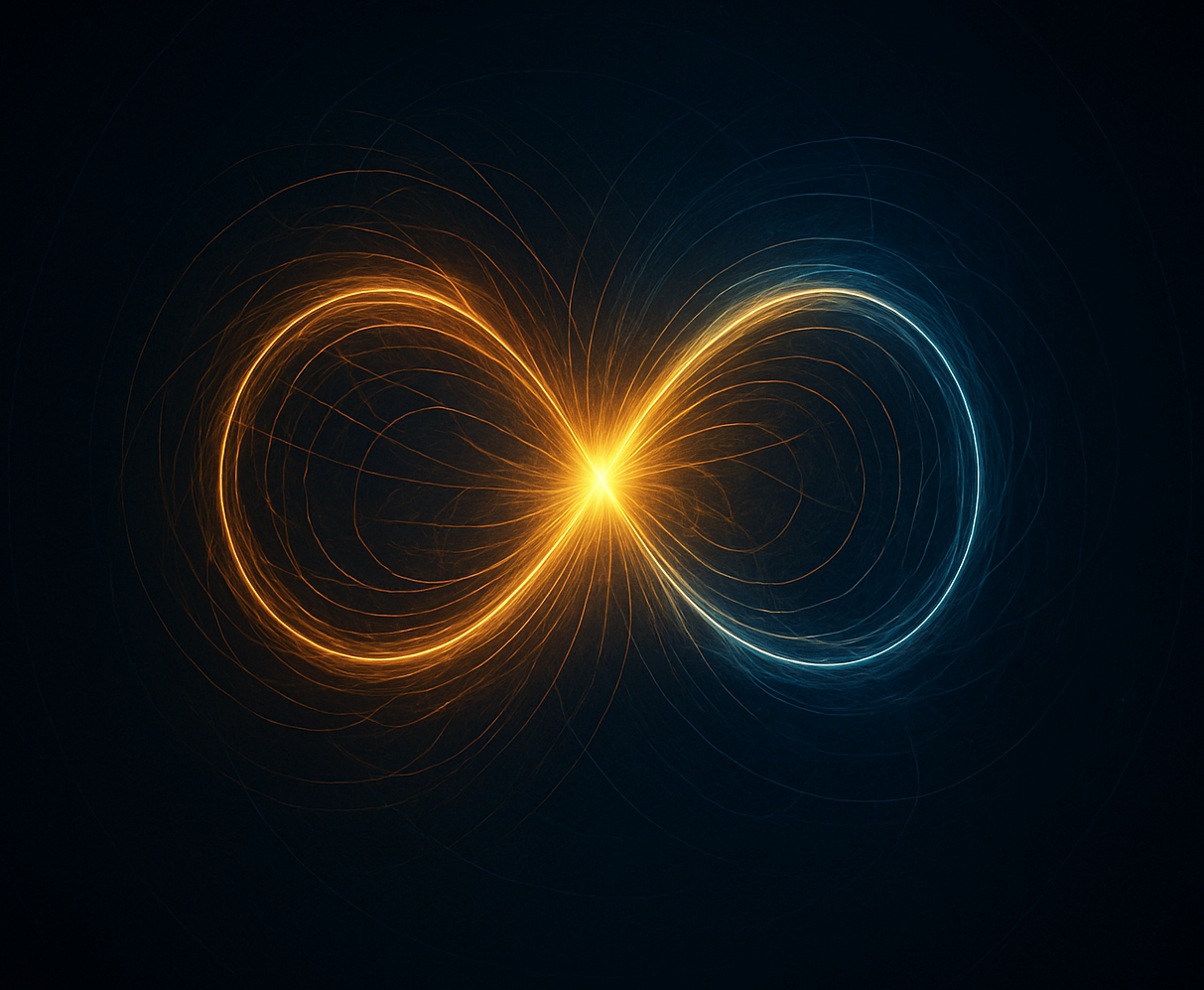Chapter 16
SED and Spin
Why does every particle have spin?
Despite what most particle physicists say today, SED maintains that spin is real angular momentum. It is not some abstract or inherent property that fundamental particles are somehow deemed to possess, but a direct consequence of the ubiquity of Planck’s Constant with value h.
SED refers to h as the new atom, for it exists in everything and can never be divided or consumed.
Spin exists in both matter and energy but for some reason conventual physics can accept that while energy may spin it insists matter does not. It acknowledges that energy like light, exists as a sinusoidal or circular wave moving at the speed of light and thus forms a kind of helix in space. Each light particle or photon always contains one unit of spin or h.
Remarkably, it is generally accepted by the modern physics academic community, that while elementary particles do indeed possess spin, they are not actually spinning! It does however accept that these particles have angular momentum, but it is an intrinsic form, arising from quantum mechanics, and not something that we humans can understand. This section proposes that this is an absurd and illogical belief, and that we now have a new model called a roton that allows us to rationally understand spin.
This new branch of physics, called Structural Electrodynamics or SED, proposes we should take another look at some of the strange claims of quantum mechanics and try to find a more physical and comprehensible view of science and the world.
Among other things, SED is concerned with how matter is made from energy and suggests that this process is entirely coherent and one that can be simply described and understood from first principles and classical physics. Additionally, all the properties of fundamental particles such as charge, spin half-h, mass, chirality, the two spin states of the electron - even what nucleons are and how the nucleus works, come about naturally as a result of the structure of these particles.
There is no need to resort to abstract mathematics, multi-dimensional space, many worlds, quarks with fractional charge, Higgs bosons that miraculously supply mass to everything in the universe, and other bazaar concepts such as isospin, strangeness, going backwards in time, or half dead cats. Ideas like these have been forced onto science due to its clinging to irrational beliefs as proposed in the standard model.
A key role of physics is to explain science, not confuse and mystify people with ideas that are more like science fiction than reality.
The standard model insists that one of the main objections to spin being real spin is that fundamental particles are point-like, and that being infinitely small, there is nothing to spin. No radius for circular motion. We will soon see how SED, in combination with the well accepted idea of wave-particle duality, escapes from this dilemma.
What really is spin?
To understand spin in relation to matter we first need to understand the structure of elementary particles and how they are formed. One of the main concepts SED invokes here is that of the Planck constant or quantum of angular momentum, often written simply as h. Its importance to this theory cannot be overstated. It is so vital to the whole concept of what particles are that SED goes on to say that if something exists, it spins with h, or some whole multiple of real angular momentum. This idea is profound but strangely seems to have been overlooked by physicists, although most will agree that h is integral to quantum physics and occurs in virtually every equation in the subject. Too often though, it seems that h is considered as merely another type of constant, whose physical importance is not especially significant. Using only elementary physics, SED hopes to change this.
The idea of a model that is spinning needs some physical entity for its construction. This is supplied by ultra-high energy electromagnetic fields or gamma rays, which experiments show can be produced when elementary particles decay. However the reverse of this process also happens, and SED contends that this is how energy creates matter. Energy that came first in the early big bang. We therefore need to understand the mechanism of how this can occur.
Moreover, if SED is correct and that energy creates matter this way, the idea of wave-particle duality additionally explains why fundamental particles can appear to have no size. They are a soliton or standing wave, moving in circular motion with a circumferential length based on their Compton wavelength or energy that the equivalent amount of light would have. However, they are not like a solid entity that is hard and has a surface. This is an illusion for particles. And because they are very tiny and wave-like, we may never discover their construction directly, hence they appear to be infinitely small, without any observable structure.
SED proposes a model and mechanism whereby matter is formed. The model is called a roton and the mechanism is the spin of E-M waves or fields. Elsewhere, I have written a number of articles about this, but it seems that conventional physics has so much inertia and self-belief in the standard model that it will be slow to change, despite many inconsistencies and shortcomings. We will see how time and fresh minds deal with this. Meanwhile, I can only write.
How does spin come about in this model and what maintains it? What makes matter? What gives it mass? The answer is Planck’s constant with its deep and far-reaching influence on everything in the universe.
Figure 35- A 3D view of the Hubius Helix or Roton (Thanks to Qiu-Hong Hu) [1]
This diagram, repeated here at left, shows the structure of the roton and that our proposed model maintains angular momentum. It shows the path that energy travels around, endlessly revolving and recreating its fields from opposites. To make a roton or particle with matter, two original gamma rays collide at 90º and superpose to form a soliton or standing wave, emitting a neutrino in the process. It is not static and the roton’s spin is always one h overall and consists of two circular loops, each carrying half the spin. Viewed from above we see the path forming two perfect circles. This is why fermions, or particles with mass, have a measured spin of half h at any one time, and yet their total spin is still one full h. Spin exists in either one loop or the other sequentially and this is what is measured. This explains a long-standing problem that particle physicists have had with the angular momentum of fermions: Why half h?. Until now, they had no idea of what spin really is or how it manifests. Now we know.
All elementary particles carry one h of angular momentum overall. Fermions, when measured, appear to have a spin of h/2 but this is an illusion. It is only the spin in each loop at any one time. All particles must have two loops that cannot be separated.
Spin is angular momentum at the smallest possible level, that of Planck’s constant and this is tiny. It forms the basis of all fundamental particles, and nothing exists without it, not even energy and fields themselves. Always conserved and never stopping, spin is the ultimate quantum or atom of the universe.
The two spin states
Experiments on electrons in magnetic fields, reveal that they can only exist in either one of two possible states, now called spin-up and spin-down. These two spin states have opposite magnetic moments and have measured spin values of +1/2 and -1/2 in units of h. This was a perplexing outcome for physicists who were unable to explain why these two states exist. They referred to it as a purely quantum phenomenon, with no analogy in our larger world, and left it at that. However, SED has a simple explanation for what is happening in electrons and other particles, with no need for anything other than classical physics and this model. During the remainder of this discussion please refer to the following diagram (Fig 28) which is repeated again for this section.
Using our roton as the model, we can see how an external magnetic field initially causes an electron to align itself with the field, in order to reduce potential energy to a minimum. This is the case as shown in the left-hand roton below (called spin-up). Now when the external magnetic is reversed, and if it has sufficient strength or energy, the electron will flip, or turn inside-out, like an umbrella. To do this it takes energy from the external field. The model shows that the magnetic field direction in each of the rotons loops is reversed, but that the electric field direction remains (1)unchanged. This is how the magnetic moment or state of the electron is reversed, but that its charge remains the same, for charge can never be created nor destroyed. Only these two states are possible in the rotons of all fundamental particles.
Figure 36 - The two states of an electron, or fundamental particle, when inverted produce opposite magnetic moments.
It was the experiments first performed by the two physicists Stern and Gerlach in early 1922 that showed this result of quantisation of angular momentum on the atomic scale using silver atoms and a spatially varying magnetic field.
The overall spin change is always h (or h-bar if we are considering radial and not circumferential angular momentum). This is the minimum that can occur. The electron is a lepton that cannot spontaneously alter its state. Only with energy supplied by the external magnetic field, can this happen.
We have seen earlier in the section on the atom that nucleons (i.e. protons and neutrons) are different to leptons and can exist in two states simultaneously due to quantum superposition and their much smaller size.
This is another example of how real spin or angular momentum exists in all particles. It is not an intrinsic property somehow endowed by them due to the fact that we simply had no better understanding or model of what spin is and what caused it. Our model shows how spin is quantised down at this subatomic level because Plank’s Constant is quantised. The two are identical phenomena.
(1) As we have said several times, a plastic strip made into a roton, marked-up with E and B fields in their correct directions and sense, when inverted like an umbrella turned inside-out, will show why this is so. This is also an example of charge conservation.
The Origin of Everything
(Online Edition)


































